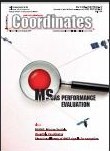
Telespazio takes control of Galileo Ground Facility
Telespazio has taken over management of a Galileo satellite constellation control centre. The company will begin cabling the entire structure as well as installing and integrating required systems and equipment for the satellite constellation and mission. Telespazio said its work will begin on the areas dedicated to security, navigation signal generation systems, orbital management and atomic clocks. The control centre is expected to be fully operational and will be inaugurated this fall. www.telespazio.it

OGC calls for Industry input on Geospatial Fusion
The Open Geospatial Consortium (OGC®) has issued a Request for Information to solicit industry input into a Fusion Standards Study to be conducted in preparation for the planned OGC Web Services, Phase 7 (OWS-7) Testbed. It will also partner with other Standards Development Organizations (SDOs) having technology relevant to fusion. www.opengeospatial.org
Delhi 3 months away from geogovernance
For the first time ever Delhi city will have a utility map through aerial photographs and also real-time monitoring of the ground situation throughout the city with the help of 64 wireless internet protocol cameras. 31 departments and agencies will be able to access this data in real time. The Rs 120 crore project called the Delhi State Spatial Data Infrastructure (DSSDI) project is in the last stages of completion. It is being done by Delhi government along with Survey of India (SOI). Times of India

Indian GPS augmentation goes ahead
ISRO has awarded an $82 million contract to Raytheon to build the ground stations for the GPS-Aided Geosynchronous Augmented Navigation (GAGAN) System. GAGAN will provide satellitebased navigation – nominally for civil aviation, but in practice for all users – over Indian airspace and adjoining areas in South and East Asia. It is a satellite-based augmentation system (SBAS) for GPS and other operational satellite navigation systems giving differential corrections. It is scheduled to be fully functional by 2013. http://raytheon.mediaroom.com

SatGuide PND Moov 300
SatNav Technologies launched the SatGuide PND Moov 300 in India. It will provide road navigation with features like voice prompted directions and a 4.3-inch touch screen. www.satnavtechnologies.com
4.7-inch Maestro PND by Magellan
Magellan announced the Maestro PND with new design, 4.7-inch Display, voice command capabilities, handsfree Bluetooth calling and highway lane assist. It has new feature “Find Your Car” which remembers the location of your car. http://promagellangps.com

Ordnance Survey works with GRACE
GRACE – the GNSS Research and Applications Centre of Excellence – has recently worked with Great Britain’s national mapping agency, Ordnance Survey. A team from GRACE carried out data collection at various sites to test potential new GNSS survey equipment. www.grace.ac.uk
Leica CloudWorx™ 1.0 for SmartPlant
Leica CloudWorx™ 1.0 for SmartPlant 3D was recently released by Leica. It is designed for Intergraph SmartPlant 3D users who want to take full advantage of accurate, laser scan asbuilt data directly in SmartPlant 3D. Leica has also released the QuickSteer motor – a new retrofi t option for farmers who want to add auto-steer functionality to their older tractors. It can be added to a wide range of agricultural vehicles that do not have factory-installed steering kits. www.leica-geosystems.com

MSAS performance evaluation under severe ionospheric conditions
Nyo Mi Saw, Nobuaki Kubo and Sam Pullen
NLRMP: Mission Possible
Maj Gen (DR) B Nagarajan, Sharad Raval and NK Agrawal
Unearthly Coordinates
Muneendra Kumar
Educational library of GNSS signals for navigation
Emanuela Falletti, Davide Margaria and Beatrice Motella

GPS import in India was derestricted in Jan,04 – Bal Krishna, june’05
If we go strictly by rule that exists on paper, making a GPS operational without a license from WPC is not allowed – P. K. Garg, July’05If GPS needs a license to operate in India then what is the procedure
for obtaining that license – Sudipto Roy, Jan07
It was easy to have detected Sumatra Offshore Earthquake from GPS – Shunji Murai and Harumi Araki, July’05 Rapid data acquisition and information services have contributed greatly to the rescue work and disaster relief efforts in Wenchuan Earthquake – Deren Li, July’08

China Navigation Map Market Report
According to China Navigation Map Market Report, 2008-2009, the Chinese car navigation market is in its early stage. In 2008, the market penetration rate of car navigation in China was only 4.56%, far lower than the 60% of Japan, and 20%-30% of both Europe and U.S.A. In 2008 a total of 3.1 million navigation devices were sold, more than double than that in 2007. www.pr-inside.com

Roadside assistance with SPOT satellite GPS messenger
SPOT Assist Roadside combines GPS and satellite communications technologies to deliver location-based messaging regardless of cellular network coverage. The “Help” button on the handheld SPOT Messenger can instantly alert a national roadside response centre of their location and need for roadside assistance from virtually anywhere in North America. The program includes fi ve roadside tows per year, up to 50 miles per tow, as well as auto-accident assistance, fuel delivery services, tyre repair etc. www.spot.com










 (5.00 out of 5)
(5.00 out of 5)